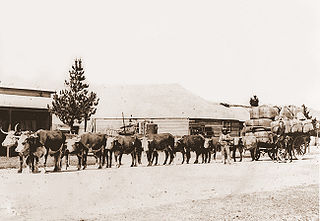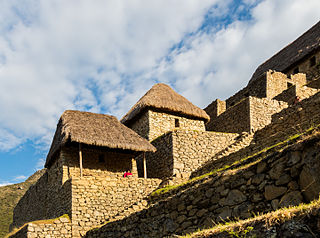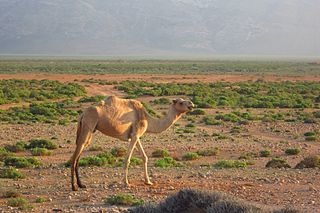
A camel is an even-toed ungulate in the genus Camelus that bears distinctive fatty deposits known as "humps" on its back. Camels have long been domesticated and, as livestock, they provide food and textiles. Camels are working animals especially suited to their desert habitat and are a vital means of transport for passengers and cargo. There are three surviving species of camel. The one-humped dromedary makes up 94% of the world's camel population, and the two-humped Bactrian camel makes up 6%. The wild Bactrian camel is a separate species and is now critically endangered.

The Clash of Civilizations is a thesis that people's cultural and religious identities will be the primary source of conflict in the post–Cold War world. The American political scientist Samuel P. Huntington argued that future wars would be fought not between countries, but between cultures. It was proposed in a 1992 lecture at the American Enterprise Institute, which was then developed in a 1993 Foreign Affairs article titled "The Clash of Civilizations?", in response to his former student Francis Fukuyama's 1992 book, The End of History and the Last Man. Huntington later expanded his thesis in a 1996 book The Clash of Civilizations and the Remaking of World Order.

Guns, Germs, and Steel: The Fates of Human Societies is a 1997 transdisciplinary non-fiction book by the American geographer, historian, ornithologist, and author Jared Diamond. In 1998, it won the Pulitzer Prize for general nonfiction and the Aventis Prize for Best Science Book. A documentary based on the book, and produced by the National Geographic Society, was broadcast on PBS in July 2005.

Bernard Lewis, was a British American historian specialized in Oriental studies. He was also known as a public intellectual and political commentator. Lewis was the Cleveland E. Dodge Professor Emeritus of Near Eastern Studies at Princeton University. Lewis's expertise was in the history of Islam and the interaction between Islam and the West.

Human history is the narrative of humankind's past. Humans evolved in Africa c. 300,000 years ago and initially lived as hunter-gatherers. Humans migrated out of Africa during the Last Glacial Period and had populated most of the Earth by the time the Ice Age ended 12,000 years ago. The Agricultural Revolution began soon afterwards in fertile river valleys of the Near East: humans began the systematic husbandry of plants and animals, and many humans transitioned from a nomadic life to a sedentary existence as farmers in permanent settlements. The growing complexity of human societies necessitated systems of accounting and writing.

The Neolithic Revolution, or the (First) Agricultural Revolution, was the wide-scale transition of many human cultures during the Neolithic period from a lifestyle of hunting and gathering to one of agriculture and settlement, making an increasingly large population possible. These settled communities permitted humans to observe and experiment with plants, learning how they grew and developed. This new knowledge led to the domestication of plants into crops.

This timeline tries to compile dates of important historical events that happened in or that led to the rise of the Middle East. The Middle East is the territory that comprises today's Egypt, the Persian Gulf states, Iran, Iraq, Israel and Palestine, Cyprus, Jordan, Lebanon, Oman, Saudi Arabia, Syria, Turkey, United Arab Emirates, and Yemen. The Middle East, with its particular characteristics, was not to emerge until the late second millennium AD. To refer to a concept similar to that of today's Middle East but earlier in time, the term ancient Near East is used.

Efraim Karsh is an Israeli–British historian who is the founding director and emeritus professor of Middle East and Mediterranean Studies at King's College London. Since 2013, he has served as professor of political studies at Bar-Ilan University. He is also a principal research fellow and former director of the Middle East Forum, a Philadelphia-based think tank. He is a vocal critic of the New Historians, a group of Israeli scholars who have questioned the traditional Israeli narrative of the Arab–Israeli conflict.

A working animal is an animal, usually domesticated, that is kept by humans and trained to perform tasks instead of being slaughtered to harvest animal products. Some are used for their physical strength or for transportation, while others are service animals trained to execute certain specialized tasks. They may also be used for milking or herding. Some, at the end of their working lives, may also be used for meat or other products such as leather.

Agriculture began independently in different parts of the globe, and included a diverse range of taxa. At least eleven separate regions of the Old and New World were involved as independent centers of origin. The development of agriculture about 12,000 years ago changed the way humans lived. They switched from nomadic hunter-gatherer lifestyles to permanent settlements and farming.

Sufi philosophy includes the schools of thought unique to Sufism, the mystical tradition within Islam, also termed as Tasawwuf or Faqr according to its adherents. Sufism and its philosophical tradition may be associated with both Sunni and Shia branches of Islam. It has been suggested that Sufi thought emerged from the Middle East in the eighth century CE, but adherents are now found around the world.
Nomadic pastoralism is a form of pastoralism in which livestock are herded in order to seek for fresh pastures on which to graze. True nomads follow an irregular pattern of movement, in contrast with transhumance, where seasonal pastures are fixed. However, this distinction is often not observed and the term 'nomad' used for both—and in historical cases the regularity of movements is often unknown in any case. The herded livestock include cattle, water buffalo, yaks, llamas, sheep, goats, reindeer, horses, donkeys or camels, or mixtures of species. Nomadic pastoralism is commonly practised in regions with little arable land, typically in the developing world, especially in the steppe lands north of the agricultural zone of Eurasia.

Jahan Salehi is an Iranian-American entrepreneur and progressive activist, He has worked for Agence Global, a left-leaning news and commentary syndicate, and as Managing Director of the Los Angeles Times Syndicate's European operations.
According to Islam, animals are conscious of God. According to the Quran, they praise Him, even if this praise is not expressed in human language. Baiting animals for entertainment or gambling is prohibited. It is forbidden to kill any animal except for food or to prevent it from harming people.

In world history, post-classical history refers to the period from about 500 CE to 1500 CE, roughly corresponding to the European Middle Ages. The period is characterized by the expansion of civilizations geographically and the development of trade networks between civilizations. This period is also called the medieval era, post-antiquity era, post-ancient era, pre-modernity era, or pre-modern era.
Rewilding means to return to a more wild or natural state; it is the process of undoing domestication. The term emerged from green anarchism and anarcho-primitivism. The central argument is that the majority of humans have been "civilized" or "domesticated" by agrarianism and sedentary social stratification. Such a process is compared to how dogs have been domesticated from what was a common ancestor with wolves, resulting in a loss in health and vibrancy. Supporters of rewilding argue that through the process of domestication, human wildness has been altered by force.

Richard Foltz is a Canadian scholar of American origin. He is a specialist in the history of Iranian civilization—what is sometimes referred to as "Greater Iran". He has also been active in the areas of environmental ethics and animal rights.

Camel urine is a liquid by-product of metabolism in a camel's anatomy. Urine from camels has been used in prophetic medicine for centuries, being a part of ancient Bedouin practices and also Muslim tradition. According to the World Health Organization, the use of camel urine as a traditional medicine lacks scientific evidence.

Yaʽfūr was a donkey used as a mount by the Islamic prophet Muhammad, who was said to have often ridden it without harness. There are many tales of this donkey but the most common would be that the donkey is recorded to have been a gift from the Byzantine governor of Egypt some time between 628 and 632 AD. According to a Shi'ite Islamic tradition, it had the power of speech and told Muhammad that it was the last of a line of donkeys ridden by prophets and was a descendant of the donkey ridden by Jesus in his triumphal entry into Jerusalem, which was also called Yaʽfūr. The tradition holds that Yaʽfūr committed suicide in despair after Muhammad died by throwing itself into a well, though these accounts are held to be unreliable in hadith studies. In the centuries after Muhammad's death, the donkey's name and symbolism was repeatedly adopted by Islamic religious figures and rulers.

The wild Bactrian camel is a critically endangered species of camel living in parts of northwestern China and southwestern Mongolia. It is closely related to the domestic Bactrian camel. Both are large, double-humped even-toed ungulates native to the steppes of central Asia. Until recently, wild Bactrian camels were thought to have descended from domesticated Bactrian camels that became feral after being released into the wild. However, genetic studies have established it as a separate species which diverged from the Bactrian camel about 1.1 million years ago.
















